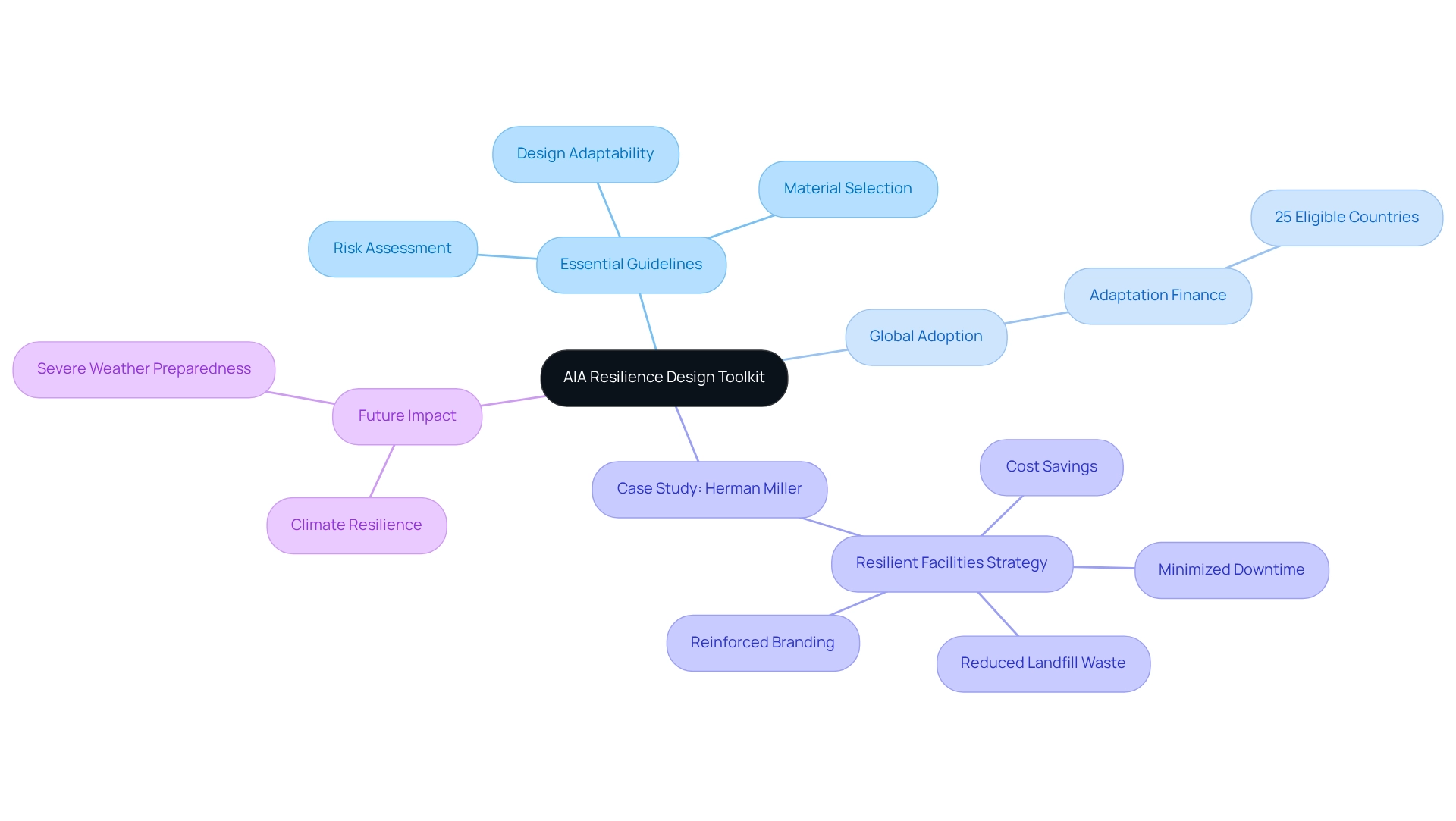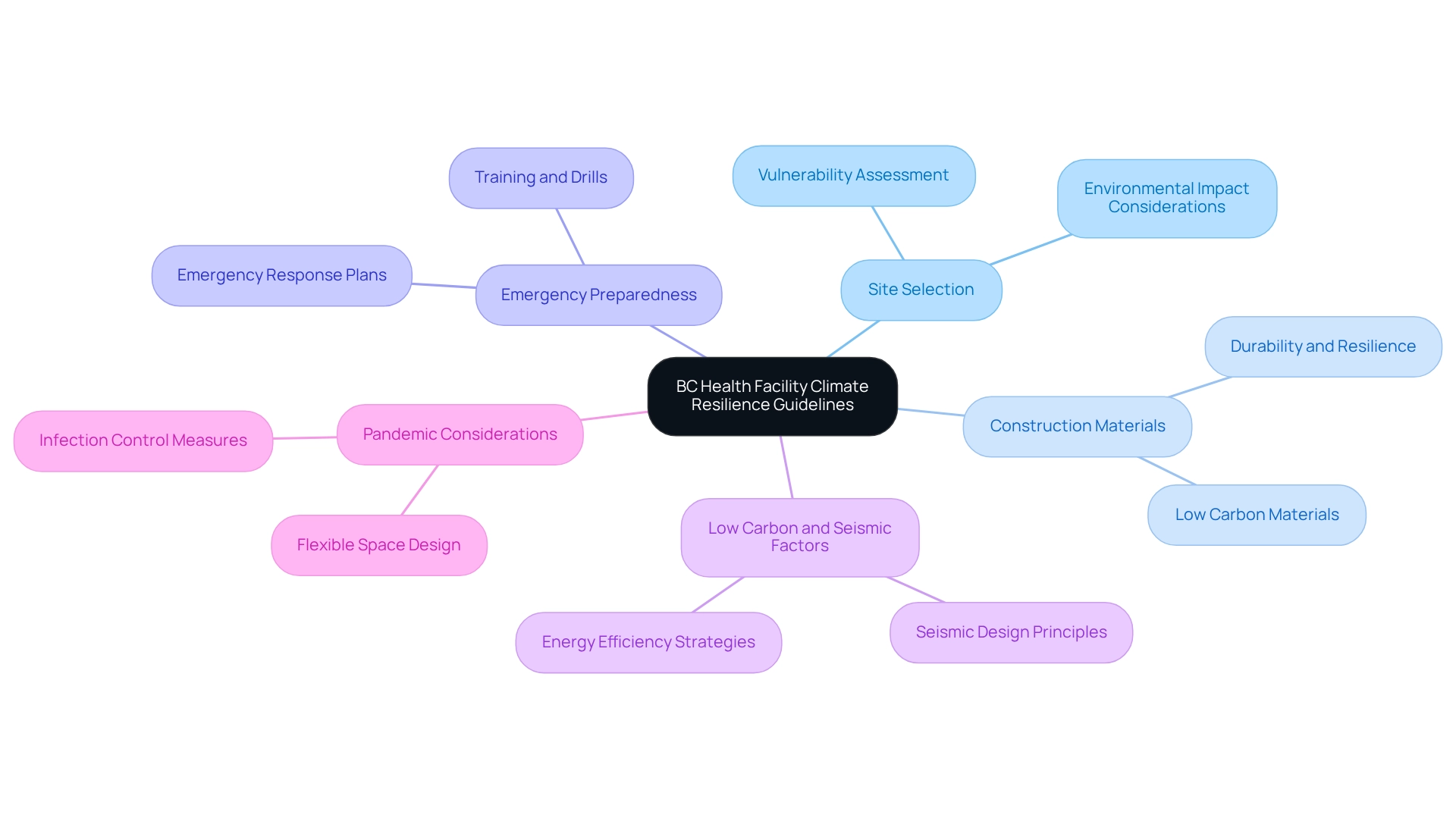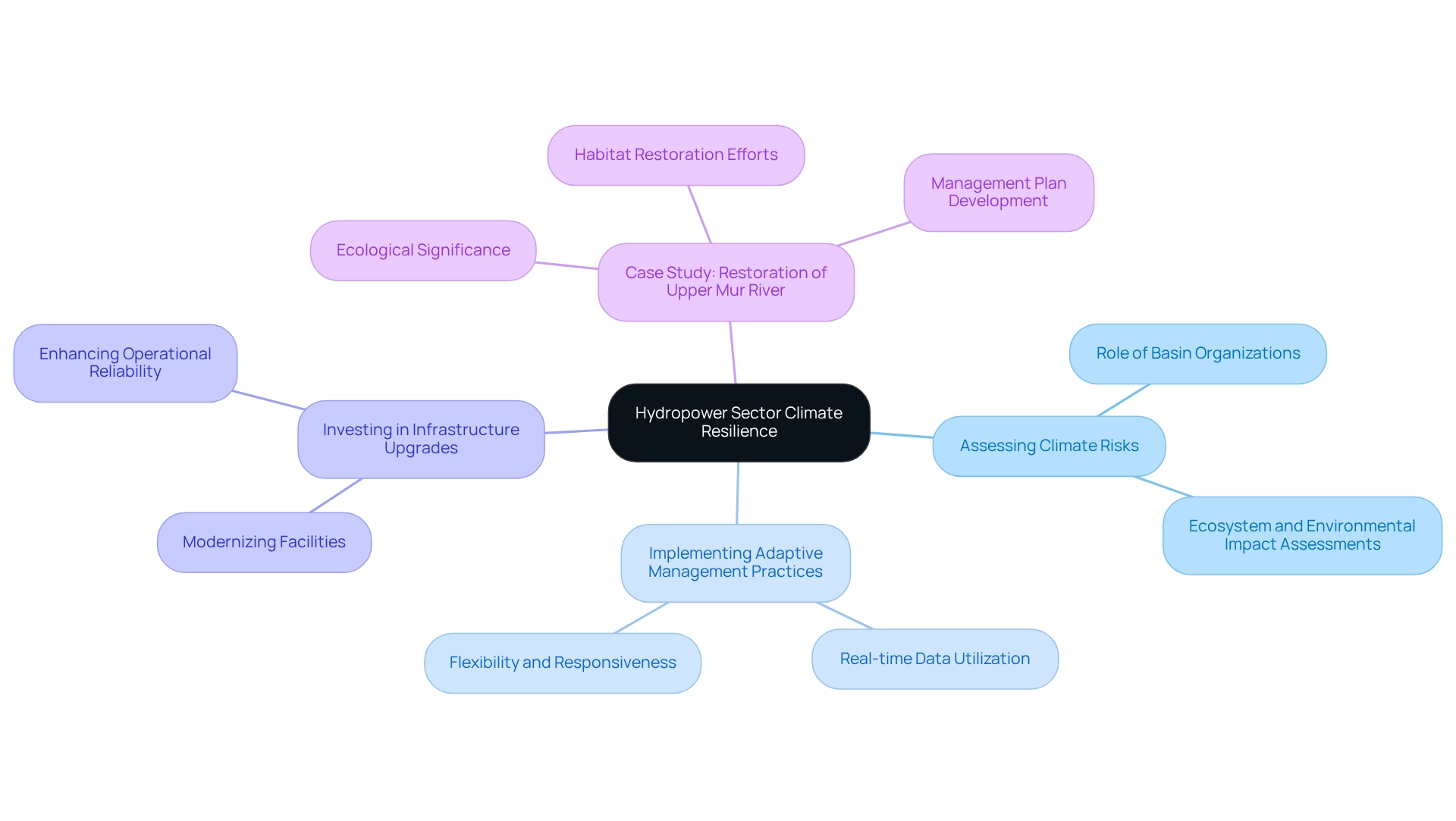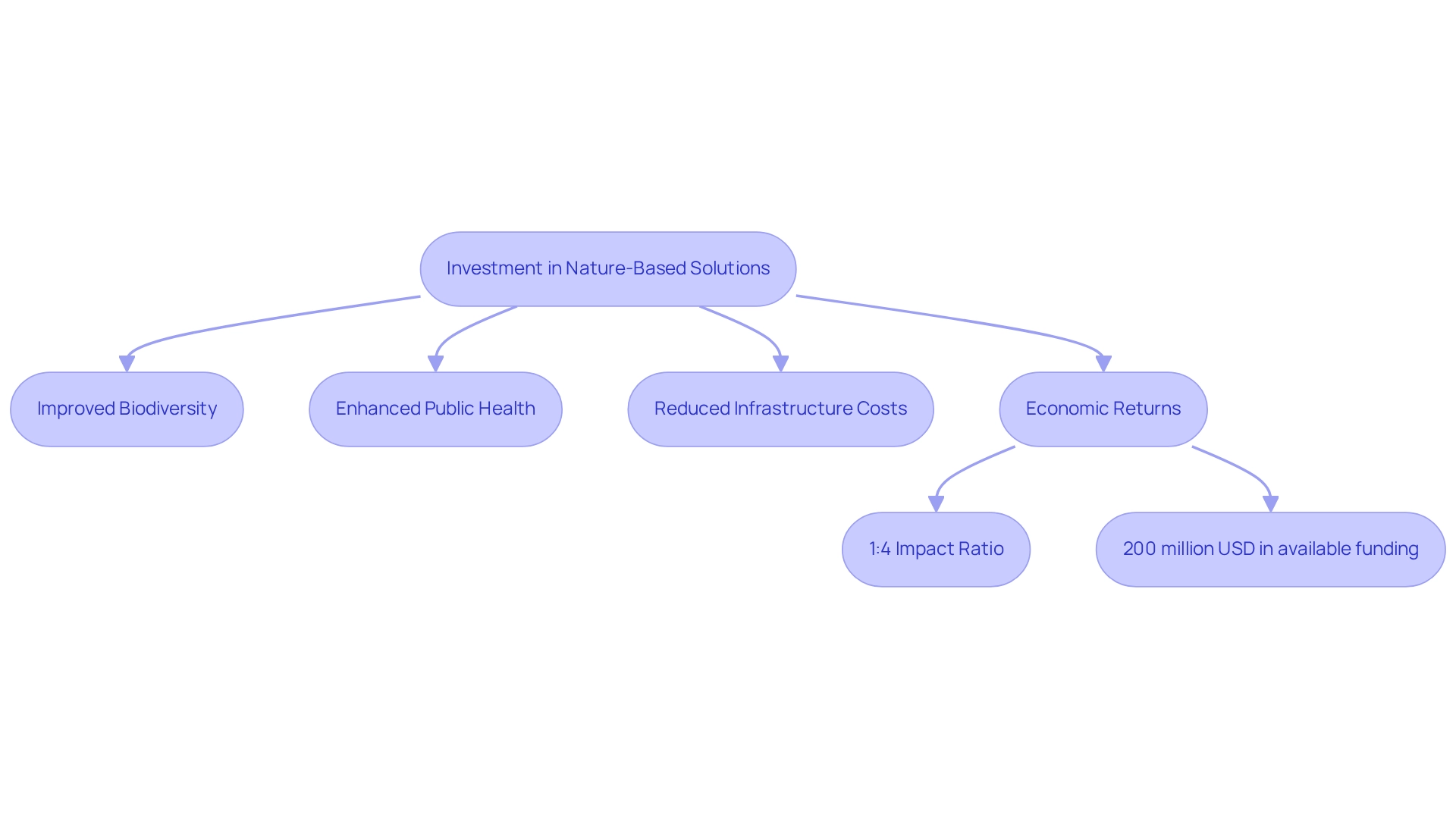Overview
This article presents essential strategies for the design of effective climate resilience projects. It emphasizes the critical need for thorough risk evaluations, robust stakeholder engagement, and the integration of nature-based solutions. Evidence supports these strategies, indicating that projects with strong risk assessment frameworks achieve a 30% higher success rate. Furthermore, active involvement of stakeholders leads to more resilient and sustainable outcomes. By adopting these strategies, organizations can significantly enhance their project effectiveness and adaptability to climate challenges.
Introduction
In light of the escalating climate challenges we face, a robust approach to resilience is more crucial than ever across various sectors. The complexities of climate adaptation demand strategic land services that facilitate resilience projects and innovative design toolkits for architects. The integration of advanced technologies and sustainable practices is fundamentally reshaping how communities adapt to environmental changes. This article explores essential strategies and resources that include:
- The pivotal role of nature-based solutions
- Comprehensive guidelines for healthcare facilities
- The implementation of resilience rating systems
By delving into these diverse initiatives, stakeholders can navigate the complexities of climate adaptation more effectively, ensuring that infrastructure and communities not only survive but thrive in an increasingly unpredictable world.
Harbinger Land | Comprehensive Solutions for Land Services in Climate Resilience Projects
In the face of escalating land acquisition challenges, Harbinger Land stands out as a leader in providing crucial land services, including:
- Site and right-of-way acquisition
- Title research
- GIS mapping
- Data processing
These services are vital for the success of climate resilience project design initiatives. Our team excels in negotiating and acquiring the leases and easements necessary for Distributed Energy Resources (DER) and infrastructure development. We utilize highly integrated GIS modeling services to facilitate efficient easements, ultimately saving clients both time and money.
By leveraging advanced technology, such as AI-powered title research software, Harbinger Land significantly enhances efficiency and accuracy in land services. This capability is essential in climate resilience project design, where timely and precise land acquisition can determine project outcomes. The experienced professionals at Harbinger Land navigate the complex legal and regulatory environment, ensuring adherence to required standards while effectively addressing environmental challenges.
As the urgency of environmental change intensifies, the role of strategic land acquisition becomes increasingly critical. Expert opinions emphasize that effective site acquisition is foundational to fostering sustainable development. In this context, Harbinger Land's commitment to utilizing technology and expertise positions us as a leader in climate resilience project design, promoting climate adaptability through comprehensive land services. Current statistics reveal that land acquisition challenges are on the rise, making Harbinger Land's services even more essential in overcoming these obstacles. Are you ready to tackle these challenges head-on? Let Harbinger Land guide you through the complexities of land acquisition, ensuring your projects succeed in an ever-changing environment.
AIA Resilience Design Toolkit: Essential Resources for Architects
The AIA Resilience Design Toolkit serves as a vital resource for architects, providing a robust framework for integrating stability into their projects. It includes essential guidelines for risk assessment, material selection, and design adaptability. By 2025, the toolkit has experienced a significant uptick in adoption among architects, reflecting an enhanced commitment to sustainable development and community engagement. Notably, statistics reveal that 25 eligible countries received adaptation finance from IDA in 2017-18, underscoring a global shift towards resilience in design.
A compelling illustration of this toolkit's application is evident in Herman Miller's Resilient Facilities Strategy. In collaboration with seasoned professionals, the healthcare system developed a strategy that minimized downtime and reinforced branding while prioritizing sustainability. As Cassie Decker, a senior account manager at OfficeWorks, aptly noted, "The client feels strongly about repurposing and keeping items out of landfills, and literally nothing from this project is going into the landfill, which is a win for everyone."
By leveraging the AIA Resilience Design Toolkit, architects can implement climate resilience project design to create buildings that not only adhere to current standards but also proactively address future environmental challenges, equipping them to withstand severe weather events and mitigate the impacts of global change.

BC Health Facility Climate Resilience Guidelines: Best Practices for Design
The BC Health Facility Climate Resilience Project Design Guidelines present essential best practices for designing healthcare facilities that effectively adapt to climate change. A critical element of these guidelines is site selection, which significantly influences a facility's vulnerability to climate-related disruptions. Developed through a year-long collaborative effort involving multiple sectors, these guidelines ensure a comprehensive approach to resilience.
Moreover, the selection of construction materials and the integration of emergency preparedness plans are emphasized to enhance robustness. These guidelines advocate for climate resilience project design approaches that incorporate low carbon, seismic, and pandemic factors. By adhering to these practices, healthcare facilities can significantly bolster their operational continuity during extreme weather events, ensuring they remain capable of delivering vital services to the community even under challenging conditions.
For land acquisition directors, understanding these guidelines is paramount. They can directly impact site selection and land acquisition choices, aligning with environmental sustainability goals. What challenges do you face in land acquisition? By integrating these guidelines into your strategy, you can navigate complexities and make informed decisions that enhance resilience and sustainability.

Hydropower Sector Climate Resilience Guide: Strategies for Sustainable Energy
The Hydropower Sector Climate Resilience Project Design presents essential strategies for bolstering the durability of hydropower projects in light of environmental changes. Acknowledging the pressing need for adaptation, we outline key strategies:
- Assessing Climate Risks: Grasping potential climate impacts is critical for effective planning and risk management. Basin organizations are instrumental in ecosystem and environmental impact assessments, offering invaluable insights for these evaluations.
- Implementing Adaptive Management Practices: These practices empower hydropower facilities to modify operations based on real-time data and evolving environmental conditions, thereby enhancing flexibility and responsiveness.
- Investing in Infrastructure Upgrades: Modernizing infrastructure not only boosts operational reliability but also ensures that facilities can endure extreme weather events and shifting hydrological patterns.
By embracing these strategies, hydropower facilities can significantly improve their operational reliability and play a pivotal role in a sustainable energy future. A notable example is the restoration of the Upper Mur River in Austria, which highlights successful adaptation by aligning ecological values with hydropower generation needs. This initiative, awarded the European River Prize in 2014, exemplifies effective river restoration methodologies, involving extensive habitat restoration and the development of a management plan that harmonizes water management, nature conservation, and energy economy. As Rudolf Hornich, Project Manager at the Office of Styrian Government, aptly stated, "Sustainable energy and environmental adaptation are essential for our future, and initiatives like the Upper Mur River restoration illustrate how we can accomplish both ecological and energy objectives."
Statistics indicate that the climate resilience project design for hydropower projects faces increasing environmental risks, necessitating proactive measures. The adoption of flexible management methods has proven beneficial for robustness, enabling facilities to more effectively navigate the uncertainties posed by environmental fluctuations. As the hydropower sector continues to evolve, these strategies will be crucial for ensuring long-term sustainability and operational success.

Resilience Rating Systems: Enhancing Investment Projects for Climate Adaptation
Durability assessment systems serve as vital instruments for evaluating the climate resilience project design of investment initiatives. These frameworks establish criteria that gauge an initiative's capacity for climate resilience project design, enabling it to withstand climate-related impacts and adapt to changing environmental conditions. By implementing durability assessment systems, investors and managers can make informed decisions that prioritize sustainability and contribute to climate resilience project design for long-term viability. This approach not only enhances investment effectiveness but also ensures significant contributions to environmental adaptation efforts, aligning with climate resilience project design.
For instance, a recent World Bank water supply initiative in Dili, Timor, allocated 10% of its investment for institutional enhancement and disaster risk management, exemplifying the principles of durability rating systems. Furthermore, the collaboration between the World Bank’s Agriculture and Food Global Practice and the RRS team led to the development of a guidance note aimed at improving risk assessments for agricultural initiatives, underscoring the necessity for sector-specific adaptability evaluations.
As Ammara Shariq noted, the Nepal transport connectivity project achieved an 'AA' rating, reflecting its robust durability measures and its positive impact on beneficiaries. As environmental adaptation investments advance, the continued use of durability assessment systems is crucial for fostering effective adjustment strategies in climate resilience project design for at-risk communities worldwide.
New Hampshire Climate Resilience Database: A Resource for Local Adaptation Strategies
The New Hampshire Resilience Database serves as an essential resource for local authorities and organizations aiming to implement effective adaptation strategies. This comprehensive database provides access to critical information, including funding opportunities, best practices, and case studies related to climate resilience project design. Local governments have increasingly leveraged the database, with a notable rise in its usage reported in 2025, reflecting a growing commitment to sustainable practices. Statistics indicate that usage has surged by over 30% compared to the previous year, underscoring its increasing significance.
A pivotal case study featured in the database is titled 'Adaptation Strategies for New Hampshire Farmers,' which underscores the necessity for farmers to adapt to rising weather variability due to environmental changes. Specialists from UNH Cooperative Extension advocate for methods such as crop diversification and assessing plant traits like drought and pest resistance to mitigate risks associated with extreme weather events.
By utilizing the insights and resources available, stakeholders can craft tailored approaches within the framework of climate resilience project design that effectively address the unique environmental challenges their communities face. This proactive strategy not only strengthens local adaptation efforts but also cultivates a more resilient future, as demonstrated by the successful climate resilience project design initiatives highlighted within the database. Furthermore, expert perspectives stress the importance of employing such resources to navigate the complexities of environmental adaptability, ensuring that communities are better prepared for the impacts of environmental change. As Jane Presby, Operator of Dimond Hill Farm, articulates, "I don’t have flooding problems. I don’t have … fog problems," showcasing the tangible benefits of effective adaptation strategies.
Moreover, local authorities are encouraged to explore financing options to enhance their environmental adaptation initiatives. Donations to support future funding of the program can be sent by mail to CCCD in Walpole, NH, with 'Climate' indicated in the memo line. This financial support can significantly bolster the capacity of local governments to implement the plans outlined in the database.
Nature-Based Solutions: Transforming Climate Resilience Planning and Design
Nature-based solutions (NbS) represent a pivotal strategy for enhancing environmental adaptability. By harnessing natural processes and ecosystems—such as restoring wetlands to mitigate flooding or implementing green roofs to alleviate urban heat—communities can effectively confront environmental challenges. The climate resilience project design that integrates NbS into environmental adaptation planning not only fosters improved biodiversity but also bolsters public health and reduces infrastructure costs.
Recent statistics underscore the efficacy of NbS, revealing that investments in these solutions can yield substantial returns. For instance, the International Union for Conservation of Nature (IUCN) has reported that their investments over the past five years have generated approximately one trillion dollars in benefits, demonstrating an impressive 1:4 impact ratio—every dollar invested returns four dollars in benefits. Furthermore, IUCN actively supports the acceleration of financing for nature-based solutions through various grant mechanisms, representing 200 million USD in available funding, thereby highlighting the financial commitment to these initiatives.
Successful initiatives worldwide exemplify the transformative potential of NbS. For example, projects aimed at enhancing urban green spaces have yielded promising outcomes in reducing heat islands, thus improving community well-being. Additionally, local farmers, such as Mevin Pérez, have expressed their appreciation for the positive changes brought about by these solutions, noting enhancements in water accessibility and agricultural productivity: "As a family, we feel grateful because we all work to take care of the plants. It used to be difficult for us to fetch water; now we no longer spend half an hour fetching a jug of water."
As financial entities align their strategies with global and domestic sustainability goals, the climate resilience project design that incorporates NbS into environmental adaptation planning becomes increasingly vital. By employing ecosystem approaches that address environmental challenges, communities can not only adapt to changing conditions but also thrive sustainably, paving the way for future initiatives in affected regions, such as those inspired by the project in South Ahuachapán.

Designing Infrastructure for Climate Resilience: Strategies Against Extreme Weather
The climate resilience project design involves creating infrastructure for climate adaptation that requires a multifaceted strategy to enhance the ability of structures to withstand extreme weather events. This necessity is underscored by the increasing frequency and intensity of such events, compelling communities to take decisive action in climate resilience project design. Key strategies include:
- Utilizing Durable Materials: The selection of materials profoundly influences the longevity and resilience of infrastructure. Durable materials can endure harsh conditions, thereby reducing maintenance costs and extending the lifespan of structures.
- Incorporating flexible design elements in climate resilience project design enables infrastructure to adapt to changing conditions, minimizing damage during extreme weather events. This can involve adjustable components that respond to environmental stresses.
- Ensuring redundancy in critical systems is an essential aspect of climate resilience project design, as redundant systems offer backup options that maintain functionality during failures. This is vital for essential services, ensuring they remain operational even when primary systems are compromised.
- Effective drainage systems are crucial for managing stormwater and preventing flooding, which is an important aspect of climate resilience project design. For example, the Park actively manages flooding generated by a 100-year return period rainfall event, illustrating the effectiveness of well-designed drainage systems. The collaboration with various stakeholders, including the London Organising Committee for the Olympic Games, has proven successful in managing flooding from significant rainfall events.
- Engaging stakeholders in the climate resilience project design process is essential for successful infrastructure projects, as collaboration among diverse stakeholders, including government entities and contractors, plays a crucial role. This collective approach ensures that various perspectives are considered, leading to more robust designs. As Barry Plowright, Senior Engineer at Atkins, noted, "Following completion of the Games, the Park is to be transformed into the Queen Elizabeth II Olympic Park to form a mixed-use development and significant landscaped area together with a number of retained venues converted for legacy usage."
- Adopting innovative technologies, such as AI-powered tools for planning and analysis, can enhance the efficiency and effectiveness of climate resilience project design.
- Conducting Regular Risk Assessments: Continuous evaluations of potential risks related to environmental change are crucial for climate resilience project design and ensure that infrastructure remains robust over time.
- In the climate resilience project design, prioritizing community engagement by involving the community in the planning process fosters a sense of ownership and ensures that the infrastructure meets local needs and expectations.
- Integrating Nature-Based Solutions into climate resilience project design allows for the utilization of natural systems, such as wetlands and green roofs, to enhance adaptability while providing additional environmental benefits.
- Focusing on long-term sustainability, climate resilience project design addresses immediate environmental challenges and contributes to the overall health and viability of communities.
By emphasizing these approaches, communities can significantly enhance their infrastructure's resilience against environmental changes, ensuring that vital services continue to function during and after severe weather occurrences.
Climate-Resilient Buildings: Key Actions for Architects and Engineers
To forge buildings that incorporate climate resilience project design, architects and engineers must prioritize several essential approaches. First, utilizing sustainable materials is crucial, as they significantly lower carbon footprints and contribute to overall environmental health. Second, designing for energy efficiency not only minimizes resource consumption but also enhances long-term cost savings. Third, integrating passive design techniques optimizes natural ventilation and lighting, thereby reducing reliance on artificial systems. Fourth, elevating structures in flood-prone areas mitigates the risk of water damage, a critical consideration as flooding events become increasingly frequent.
As Ross Perot aptly stated, "The activist is not the man who says the river is dirty. The activist is the individual who restores the river," emphasizing the proactive role that experts can adopt in environmental sustainability. By applying these strategies within the climate resilience project design, professionals can significantly enhance the durability of structures against the adverse impacts of environmental change. Notably, the adoption of environmental adaptation measures is projected to generate $7.1 trillion in net benefits by 2030, underscoring the economic feasibility of these practices.
Successful projects that have embraced sustainable materials and energy-efficient designs serve as compelling case studies for climate resilience project design. For instance, recent flood preparedness legislation in states like Virginia and New Hampshire establishes funds for flood preparedness and mandates disclosures about flood risks, demonstrating how legislation aids resilience efforts related to the environment. Moreover, as Edward Everett Hale highlighted, personal initiative is essential; each professional's dedication to these approaches can yield considerable effects. Staying informed on evolving state policies is also vital for ensuring effective environmental adaptation efforts, enabling architects and engineers to adjust their designs to meet current regulations and best practices.
Essential Strategies for Effective Climate Resilience Project Design: A Comprehensive Overview
A multifaceted strategy that encompasses several essential components is necessary for effective climate resilience project design.
- Thorough Risk Evaluations: Identifying vulnerabilities through comprehensive risk evaluations is crucial for understanding potential impacts and guiding decisions. Statistics indicate that effective risk assessments significantly enhance results, allowing teams to proactively address challenges. Studies show that initiatives with strong risk assessment frameworks have a 30% higher success rate in achieving their objectives compared to those lacking.
- Stakeholder Engagement: Engaging stakeholders throughout the planning process is vital for incorporating diverse perspectives and fostering community support. Successful projects demonstrate that active stakeholder involvement leads to more resilient solutions, ensuring that the needs and concerns of all parties are addressed. As Yizhao Yang, a professor at the University of Oregon, notes, "The CDEZ’s materialization process speaks to Chengdu City’s incremental, adaptive, and experimental approach to peri-urban planning," highlighting the importance of stakeholder engagement in achieving effective outcomes.
- Nature-Based Solutions: Integrating nature-based solutions can enhance ecological resilience, providing sustainable alternatives that work in harmony with the environment. These strategies mitigate risks while promoting biodiversity and improving community well-being. For example, the construction of pit latrines in La Moskitia, Honduras, has led to better sanitation and reduced pollution in local waterways, showcasing the effectiveness of nature-based approaches in improving community health.
- Advanced Technologies: Utilizing cutting-edge technologies for data analysis and task management streamlines processes and enhances decision-making. The use of AI and GIS tools can greatly improve efficiency and precision in execution, enabling teams to analyze data more effectively and make informed choices.
- Clear Success Metrics: Establishing clear metrics for assessing success and adaptability is essential. This enables groups to evaluate progress and implement necessary changes, ensuring that initiatives remain efficient in the face of changing environmental challenges.
By applying these strategies, teams can create robust solutions that effectively address the challenges presented by environmental change, ultimately aiding in sustainable development and incorporating climate resilience project design for community welfare. Furthermore, exploring innovative funding mechanisms, such as revenue generation from increased land value and land lease income, can further support stakeholder engagement and resource allocation for climate resilience projects.
Conclusion
The multifaceted approach to climate resilience outlined in this article highlights the urgent need for strategic planning across various sectors to effectively combat the impacts of climate change. Nature-based solutions play a pivotal role in enhancing biodiversity and public health, while comprehensive guidelines for designing resilient healthcare facilities underscore the essential strategies for fostering sustainable development.
Advanced technologies, such as AI-powered tools and GIS mapping, empower stakeholders to navigate the complexities of climate adaptation. By employing resilience rating systems and engaging in thorough risk assessments, communities can make informed decisions that protect their infrastructure and ensure the continuity of vital services during extreme weather events.
The emphasis on collaboration and stakeholder engagement underscores the importance of collective action in building resilience. Successful case studies and the increasing adoption of innovative practices illustrate that these strategies are not merely theoretical; they represent practical solutions leading to tangible benefits for communities facing climate challenges.
In conclusion, the path toward climate resilience is illuminated by informed decision-making, innovative design, and a commitment to sustainability. By prioritizing these strategies and leveraging available resources, stakeholders can create a future where both infrastructure and communities not only survive but thrive amidst the uncertainties of climate change. The time to act is now, and the potential for positive impact is immense.
Frequently Asked Questions
What services does Harbinger Land provide for land acquisition?
Harbinger Land offers site and right-of-way acquisition, title research, GIS mapping, and data processing services, which are essential for climate resilience project design initiatives.
How does Harbinger Land enhance efficiency in land services?
Harbinger Land utilizes advanced technology, including AI-powered title research software, to significantly improve efficiency and accuracy in land services.
Why is timely land acquisition important in climate resilience project design?
Timely and precise land acquisition is crucial as it can determine the outcomes of climate resilience projects, ensuring they are successfully developed and implemented.
What role does Harbinger Land play in infrastructure development?
Harbinger Land excels in negotiating and acquiring leases and easements necessary for Distributed Energy Resources (DER) and infrastructure development.
How does Harbinger Land navigate legal and regulatory challenges?
The experienced professionals at Harbinger Land navigate the complex legal and regulatory environment, ensuring adherence to required standards while addressing environmental challenges.
What is the significance of strategic land acquisition in the context of environmental change?
As environmental change intensifies, strategic land acquisition becomes increasingly critical for fostering sustainable development, making Harbinger Land's services essential in overcoming land acquisition challenges.
How does Harbinger Land's commitment to technology and expertise position it in the market?
Harbinger Land's commitment to utilizing technology and expertise positions it as a leader in climate resilience project design, promoting climate adaptability through comprehensive land services.
List of Sources
- Harbinger Land | Comprehensive Solutions for Land Services in Climate Resilience Projects
- 30 of the Most Impactful Climate Change Quotes - Curious Earth (https://curious.earth/blog/climate-change-quotes)
- 15 Inspirational Quotes On The Environment | EcoMENA (https://ecomena.org/inspirational-quotes-environment)
- AIA Resilience Design Toolkit: Essential Resources for Architects
- Lesotho Transport Infrastructure and Connectivity Project - CPI (https://climatepolicyinitiative.org/gca-africa-adaptation-finance/case_studies/lesotho-transport-infrastructure-and-connectivity-project-2)
- A Healthcare System Plans for Resilience - Case Studies - Herman Miller (https://hermanmiller.com/research/categories/case-studies/a-healthcare-system-plans-for-resilience)
- BC Health Facility Climate Resilience Guidelines: Best Practices for Design
- Climate Resilience Guidelines for BC Health Facility Planning & Design – Green Care (https://bcgreencare.ca/resource/hf-climate-resilience-guidelines)
- Climate resilience guidelines for BC health facility planning and design (https://preventionweb.net/publication/climate-resilience-guidelines-bc-health-facility-planning-and-design)
- Hydropower Sector Climate Resilience Guide: Strategies for Sustainable Energy
- Austria: Restoration of Mur River: ecological values and hydropower generation aligned (# 456)(2) - GWP (https://gwp.org/en/learn/KNOWLEDGE_RESOURCES/Case_Studies/Europe/austria-restoration-of-mur-river-ecological-values-and-hydropower-generation-aligned--4562)
- Resilience Rating Systems: Enhancing Investment Projects for Climate Adaptation
- Climate Change | Building resilience in investment projects (https://blogs.worldbank.org/en/climatechange/building-resilience-in-investment-projects--the-power-of-resilie)
- New Hampshire Climate Resilience Database: A Resource for Local Adaptation Strategies
- Climate Resilience Grant | CCCD (https://cheshireconservation.org/climate)
- Climate change is hurting NH farmers. Climate resiliency offers a path forward. • New Hampshire Bulletin (https://newhampshirebulletin.com/2023/08/03/climate-change-is-hurting-nh-farmers-climate-resiliency-offers-a-path-forward)
- Nature-Based Solutions: Transforming Climate Resilience Planning and Design
- Giving nature breathing room builds climate resilience (https://climatechangenews.com/2025/04/22/giving-nature-breathing-room-builds-climate-resilience)
- Facts about the nature crisis (https://unep.org/facts-about-nature-crisis)
- Nature-based Solutions for climate (https://iucn.org/our-work/topic/nature-based-solutions-climate)
- Designing Infrastructure for Climate Resilience: Strategies Against Extreme Weather
- Olympic Park, London (https://susdrain.org/case-studies/case_studies/olympic_park_london.html)
- Subnational Climate Fund - CPI (https://climatepolicyinitiative.org/gca-africa-adaptation-finance/case_studies/subnational-climate-fund-2)
- Climate-Resilient Buildings: Key Actions for Architects and Engineers
- 100+ inspirational and powerful quotes on Sustainability (clustered by topic) - Twenty Now (https://twentynow.com/sustainability-initiatives/sustainability/100-inspirational-and-powerful-quotes-on-sustainability-clustered-by-topic)
- Building Climate Resilience in 2025: States Address Wildfires, Heat, and Flooding | National Caucus of Environmental Legislators (https://ncelenviro.org/articles/building-climate-resilience-in-2025-states-address-wildfires-heat-and-flooding)
- Climate-resilient buildings are the way forward for finance, architects, and engineers (https://worldgbc.org/article/climate-resilient-buildings-are-the-way-forward)
- Essential Strategies for Effective Climate Resilience Project Design: A Comprehensive Overview
- The Planning and Development of the Chengdu Ecological Zone (CDEZ): A Case study of peri-urban planning for sustainable land management and urban-rural integration - The International Partnership for the Satoyama Initiative (IPSI) (https://satoyamainitiative.org/case_studies/the-planning-and-development-of-the-chengdu-ecological-zone-cdez-a-case-study-of-peri-urban-planning-for-sustainable-land-management-and-urban-rural-integration)
- Case Studies | Reef Resilience Network (https://reefresilience.org/case_studies)




